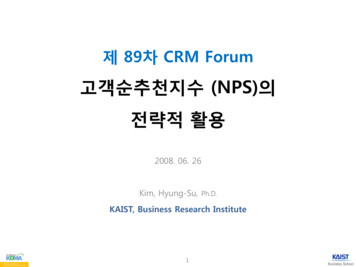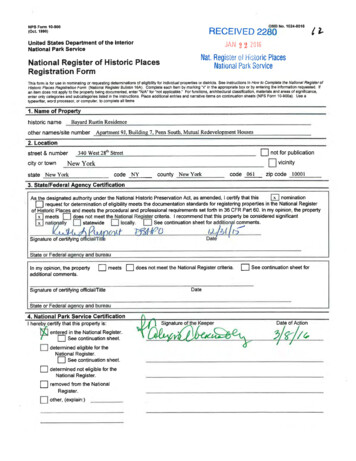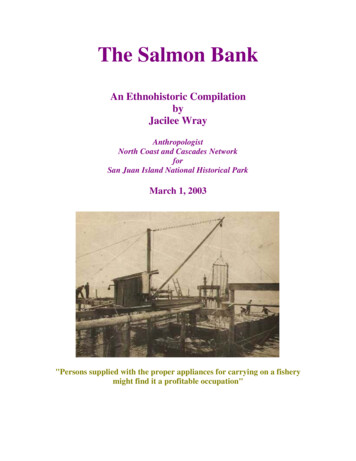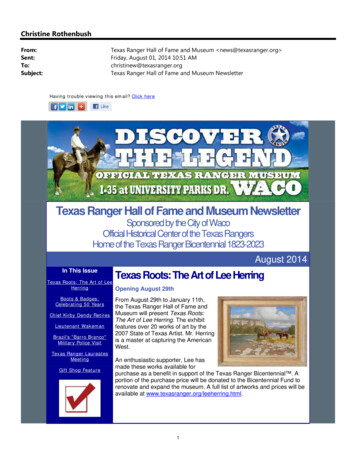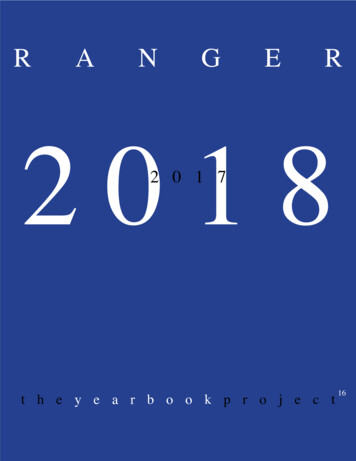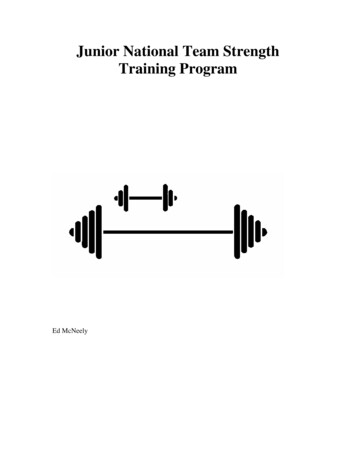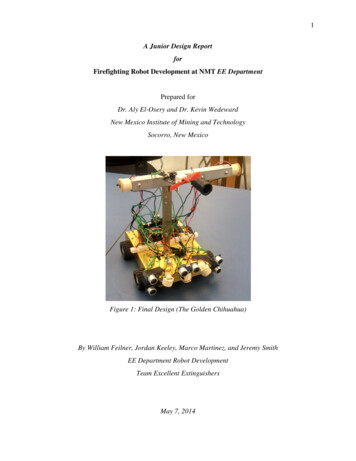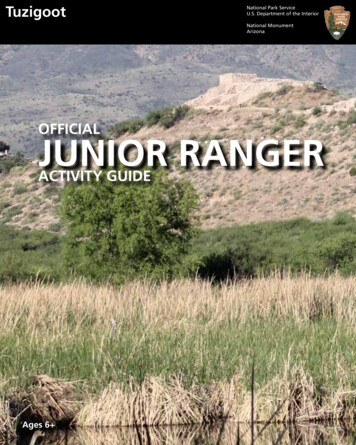
Transcription
TuzigootNational Park ServiceU.S. Department of the InteriorNational MonumentArizonaOFFICIALJUNIOR RANGERACTIVITY GUIDEAges 6
Welcome, Ranger!Junior Park Rangers explore, learn about,and help protect national parks. Follow theseinstructions to earn your official Junior Rangerbadge and certificate. You can also purchasea Junior Ranger patch if you show yourcertificate at the store.Rangers Always Work SafelyIt can get really hot here, and most of Tuzigootdoesn’t have much shade. That doesn’t meanyou can’t go outside. Just make sure you drinklots of water and wear sunscreen. Wear a hat ifyou have one!How old are you?If you are 6 or 7 years old, do the activitieson each page with the Sonoran mud turtle.If you are 8 or 9, do the activites that havethe turtle and the activities with the Arizonasycamore leaf.If you are 10 or older, do all the activities inthe book, including those with the macaw.Grown-UpsThe Junior Ranger program should take 30–60 minutes for your child to complete,about as long as most families spend at the monument.If your child does not finish before you leave, no problem! The monument’s address ison the back of this booklet. They can finish later and mail it to us, and we’ll send theirofficial Junior Ranger badge and certificate to your address.Special thanks to Mike Gooch, Rand Guthrie, and Kathleen Osterhaus for donating their artistic talents to this project.
3What is Archeology?Archeology is simply the study of how people lived in the past. Archeologistsare people who study the things those people left behind and use them to betterunderstand how they lived.Any object made or used by humans counts as an artifact . Arrowheads and pottery areartifacts, but so is this book!Archeologists excavate and take careful records of what they uncover to learn aboutthe past. In 1933 and 1934, archeologists excavated this pueblo and named it Tuzigoot.Unfortunately, archeology is also destructive! Think about it—once you move anartifact, you can never put it back exactly like it was before. All of the dirt and otherartifacts around it, called context , will be disturbed. Even the National Park Servicedoesn’t excavate very often any more, for the same reason.Excavating Your LifeImagine that an archeologist is going to excavate your room 100 years from now. Namefive things they might find that would be clues about your life.What could an archeologist learn about you from those five artifacts?All of the items in your bedroom are in context. Could the archeologist still learn aboutyou if those items were scattered around your neighborhood?Why is it important to leave artifacts in place when you find them?
4Museum Scavenger HuntThe people who lived at Tuzigoot were farmers. They also hunted and gathered foodsthat grew wild.Do some hunting of your own—see if you can find these items in the museum. Along theway, you’ll discover the same kinds of questions archeologists have tried to answer aboutthese same artifacts!Find an item that is evidence ofHunting. What is it? What is it made of?ClothingFind somethat a Sinagua person would wear. Describe it. What’s it madeout of? What does this tell you about the person who wore it?What can you find in the museum that is evidence ofdid the Sinagua people grow?Farming? What kinds of plantsNot everything in life was about survival. Can you find evidence ofdid you find? How do you think it was created?Artwork? What
5How many pots can you find?Count as many pots as you can find in the museum. Write the number and draw yourfavorite one here. What would you put in it?
6Then and NowTuzigoot is a special place. People have lived in the Verde Valley for over 13,000 years andbuilt Tuzigoot’s first rooms over 900 years ago.The Sinagua Indians learned how to adapt and survive by using what they could findin nature or through trade with neighbors. They had many skills such as weaving cloth,making pottery and tools, and creating baskets.We learn about how they lived by studying the things they left behind. By looking atthese artifacts , we see that they were not that different from us!Compare the items below and draw a line from the item in the left column to the item inthe right column that matches it. (Hint: You can find answers in the museum.)T hingswUsed NoT hingsenhTdesU
7Searching for CluesExcavating artifacts is just one part of anarcheologist’s job. Each artifact is a clue—you have toput all of them together to see what story they tell!Archeologists compare artifacts very carefully tounderstand who made them, why, and what theywere used for. Look at these pots, and draw a linebetween ones that match. Be careful! Just like at areal excavation, there may be more than one pair.!sihtl onlewDIf archeology is like a mysterybook, then excavating is liketearing out every page afteryou read it. If you miss a clueor don’t take good notes, youcan never go back for a secondlook at how things were beforeyou dug them up.Because of this, sometimesarcheologists decide not toexcavate! If we preserve a siteinstead, future technology maylet archeologists investigatewithout ever having to disturbthe ground.
8Prehistoric StyleDo you ever think about what the designs and style of your clothing mean? How is whatyou wear different from what your mom or dad or great great grandparents used towear? What about clothing in the United States versus other places?Style is one kind of clue archeologists look for. It can tell us how old something is, whereit came from, who made it, and many other details. And it works on more than justclothing—it’s also true for pottery, jewelry, stone tools, and even buildings.UndecoratedPlainware(897 Sherds, plus108 Complete Bowls)JedditoBlack-on-Yellow(734 Sherds)Hopi Culture1350–1600Sinagua Culture1100–1400GilaPolychrome(6 ay(237 hite(4 iteSpindle WhorlAncestral PuebloanCulture1150–1225
9Understanding the CluesIn archeology, style is called seriation . Now you give it a try. The notes on page 8 are allfrom a real archeology report written when Tuzigoot was first excavated! A sherd is abroken piece of pottery. See if you can figure out what their clues mean.Pottery style helps archeologists start figuring out when places like Tuzigoot wereoccupied. When is the earliest time people might have lived here? (Hint: Whenwas the oldest kind of pottery here first made?)When is the latest time people might have lived here?Based on the pottery we have, those times are the earliest and latest possible, butthere’s an even better clue. The largest number of pottery sherds are probably theones they made themselves and used most. Which pottery was made at Tuzigoot?When? That’s the most likely time period Tuzigoot was occupied!Other kinds of pottery found here were probably acquired through trade. If that’strue, then what cultures did the people from Tuzigoot trade with?&serohCkroweHomPeople of all ages lived atTuzigoot, including kids likeyou. What kinds of choresdo you do at home that kidshere might have done, too?A:One piece of pottery was recycled into around spindle whorl after it broke. Spindlesare used to spin cotton into yarn, so what canwe guess about the Sinagua from those clues?
10Pueblo TrailGo outside and explore the trail through Tuzigoot pueblo. See if you can find the answersto these questions.Tuzigoot is a very large pueblo—one of the biggest in the entire Verde Valley. It’s alsovery old. How many rooms are here? When were its oldest rooms built?If you drove a long way to get here, Tuzigoot might seem like it’s in the middle ofnowhere! Even a thousand years ago, though, people who lived here had neighbors. Findthe sign entitled “Line of Sight.” What three other pueblos were close to Tuzigoot?eesuoy?woCannmePeople at Tuzigoot might havecommunicated by sight with peoplefrom other villages. How do youthink they did it?A:
11A View from on TopJust like back then, nearby communities can still be seen from the top of Tuzigoot’shighest room. Do you know what towns they are?towThe biggest town near Tuzigoot, named after a kind of tree that grows in Tavasci marsh.CakThe town close by that was built to extract copper brought from the mines.JeThe billion-dollar town visible on the mountain slope nearby.Unscramble the circled letters above to complete the sentence below:Junior Rangersexplore, , and protectAmerica’s national parks!
12Mats and3. WateringFa r m sImagine you lived at Tuzigoot over 700years ago. What could you get fromthe marsh to help you with these dailyactivities? Place each activity’s numberin the circles at the marsh.4. BuildingRo o m s1. E a t i n gLunchTavasci Marsh made Tuzigoot a greatplace to live! It provided food, water,clothing, and shelter.Bask e t s2. Weavi ngTavasci Marsh Trail
13Poetry CornerA haiku is a kind of poetry that always has three lines and 17 syllables or beats. The firstline is five syllables long, the second is seven syllables long, and the third is five again.Look at the example, then write a haiku of your own about your visit to Tuzigoot.1234Your Turn!5An cient Pue blo HomeLine 1:1234567Line 2:What was it like to live here?Line 3:Ar ti facts tell us.12345
14Share with a Park Ranger.Write about something you learned today that surprised you or that you foundinteresting. Draw a picture to go along with what you learned. Share your picture withthe park ranger when you get your badge.Dre!ehraw
SleeaThis certifies thatnthas admirably performed all the necessary requirementsand has qualified to become a Junior Park Ranger atCeAfocehtieavciemefitrd o n t his DaBy Park RangerTuzigoot National Monumentte
thguohTlanFiPark Rangers come from many backgrounds. The rangers who wrote thisbook came from Arizona, Tennessee, New York, Washington, Michigan,and Venezuela. Some are naturalists and scientists, while others are artists,linguists, police officers, computer programmers, and veterans.One of rangers’ most important jobs is preserving America’s special placesand telling their stories until the next generation of rangers is ready to takeover. Will you someday wear the flat hat and protect these national treasures?As a Junior Ranger, I willLeave all plants, animals, and other objects as I found them for others to enjoy,Put litter in a trash can or recycle bin,Learn more about national parks all over the United States, andShare what I have learned with my family and friends.Tuzigoot National Monument P.O. Box 219 Camp Verde, Arizona 86322
Tuzigoot is a special place. People have lived in the Verde Valley for over 13,000 years and built Tuzigoot’s first rooms over 900 years ago. The Sinagua Indians learned how to adapt and survive by using what they could find in nature or through trade wi
